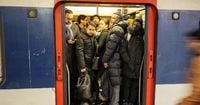On May 2, 2025, a difficult day for SNCF public transport users unfolded as disruptions hit RER and Transilien lines across Paris. The chaos began around 3:20 PM when a power failure at Gare du Nord caused significant delays and interruptions in service, affecting thousands of commuters eager to return home or start their weekends.
Initially, the SNCF reported an electrical fault at Gare du Nord, stating that the RER B was experiencing delays of 20 to 45 minutes due to the incident. The situation escalated quickly, with train traffic completely halted between Gare du Nord and Châtelet-Les-Halles. The anticipated resumption of normal service, initially scheduled for 3:45 PM, was pushed back to 5:15 PM, and eventually to 7:00 PM.
As commuters waited in frustration, the impact of the power outage extended to the RER D as well. Train traffic between Paris Gare de Lyon and Gare du Nord was entirely suspended, with the SNCF estimating that service would not resume until 7:00 PM. "We’re stuck here with no clear information. It’s frustrating, especially on a Friday evening!" expressed one anonymous traveler at Gare du Nord.
By 4:20 PM, the disruptions had begun to affect the Transilien line K, which was interrupted between Paris Gare du Nord and Crépy-en-Valois until 8:00 PM. Meanwhile, the RER C and E lines faced additional challenges due to temperature variations causing rail expansion, with rail temperatures potentially reaching 46 °C. The SNCF explained, "The temperature variations create rail expansion, and teams are monitoring rail temperature and expansion in real-time to implement necessary traffic measures."
The RER C was experiencing disruptions from Paris Austerlitz towards Massy-Palaiseau, particularly on track 1bis in Ivry-sur-Seine. The SNCF noted that these weather-related issues could lead to significant slowdowns, as extreme temperatures have historically affected the punctuality of the network.
The chaos at Gare du Nord was palpable, with crowded platforms and anxious travelers trying to navigate alternate routes. Many were forced to improvise, taking crowded buses or seeking connections at less congested stations. The RER B, crucial for connecting Paris to its suburbs and the Roissy-Charles-de-Gaulle airport, saw service interruptions that left many passengers isolated.
In an effort to mitigate the impact, the SNCF deployed additional trains from Laplace station towards Robinson, encouraging passengers to change trains there to continue their journeys. However, the influx of travelers at Laplace turned the normally quiet station into a bustling hub, leading to extended wait times.
As the afternoon wore on, the disruptions began to ripple across the entire transport network. The Transilien line H saw multiple train cancellations, while the K line remained completely interrupted until the evening. Despite the chaos, TGV and TER services appeared to be unaffected, maintaining their schedules and leaving travelers feeling frustrated with the disparity in service quality.
Social media was abuzz with reactions from frustrated commuters. "This is the third outage in a month! It’s unbearable. We pay for a service that doesn’t deliver!" lamented one user on X. Others took to humor, sharing memes about their "adventures" on the RER, showcasing a community of users who, despite their frustrations, demonstrated resilience in the face of recurring issues.
The incident raised broader questions about the reliability of public transport in Paris. Many commuters depend on the RER for their daily commutes, and when these services fail, it disrupts not only individual journeys but the entire rhythm of the city. The reliance on these lines highlights the inequalities faced by residents of the suburbs who depend heavily on public transport.
In light of the ongoing challenges, authorities and operators have promised improvements. Projects aimed at modernizing the network and investing in new trains are in progress, but their effects will take time to materialize. Meanwhile, passengers are calling for better communication during crises and increased investment in infrastructure to prevent future outages.
As the day drew to a close, the SNCF announced that the power issues had been resolved, and traffic was gradually resuming. However, significant delays remained, and travelers were advised to expect continued disruptions. This incident on May 2, 2025, serves as a stark reminder of the fragility of the transport system in Paris, leaving many to wonder how future improvements will unfold.
In the end, commuters were left hoping for smoother journeys ahead and a transport network that can meet their needs. As they shared their experiences and coping strategies, the solidarity among travelers became a small comfort in an otherwise challenging day.






